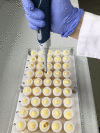Comparison of Sealing Abilities Among Zinc Oxide Eugenol Root-Canal Filling Cement, Antibacterial Bioceramic Paste, and Epoxy Resin, using Enterococcus faecalis as a Microbial Tracer
- PMID: 35771490
- PMCID: PMC9169682
- DOI: 10.12659/MSMBR.936319
Comparison of Sealing Abilities Among Zinc Oxide Eugenol Root-Canal Filling Cement, Antibacterial Bioceramic Paste, and Epoxy Resin, using Enterococcus faecalis as a Microbial Tracer
Abstract
BACKGROUND This study aimed to compare sealing abilities among 3 root canal sealers, using Enterococcus faecalis as a microbial tracer. MATERIAL AND METHODS Sixty-six straight single-rooted teeth were subjected to crown removal at the cementoenamel junction. Root canals were instrumented using the crown-down technique. Prepared teeth were randomly divided into 3 groups of 22 teeth each, according to the sealer used: Canason zinc oxide eugenol root-canal filling cement, Well-Root ST antibacterial bioceramic paste, and AH 26 epoxy resin. Root canals were obturated using the lateral condensation technique, then stored at 37°C and 100% humidity for 1 week to allow sealers to set completely. Subsequently, bacterial leakage was tested using a 2-chamber method. Twice weekly, fresh E. faecalis was placed into the coronal portion of the filled root canal. Specimens were monitored at 24-h intervals for 33 days. The number of leaking samples and mean interval until leakage were compared among groups. RESULTS The mean intervals until leakage were 5.8 days in the Canason group, 1.5 days in the Well-Root ST group, and 13.3 days in the AH 26 group. These mean intervals significantly differed between the Canason and Well-Root ST groups (P=0.035) and between the AH 26 and Well-Root ST groups (P=0.012). After 33 days, survival rates were 31.8% in the Canason group, 90.9% in the Well-Root ST group, and 68.2% in the AH 26 group (P.
Conflict of interest statement
Figures




Similar articles
-
Bacterial coronal leakage after obturation with three root canal sealers.J Endod. 2001 Jan;27(1):36-9. doi: 10.1097/00004770-200101000-00011. J Endod. 2001. PMID: 11487161 Clinical Trial.
-
Comparative evaluation of the fracture resistance of teeth prepared with rotary system, filled with single cone gutta-percha and laterally condensed with zinc oxide eugenol and resin based (AH26) sealers to that of Resilon.J Contemp Dent Pract. 2012 Nov 1;13(6):773-81. doi: 10.5005/jp-journals-10024-1228. J Contemp Dent Pract. 2012. PMID: 23404002
-
Microbial leakage of Cavit, IRM, and Temp Bond in post-prepared root canals using two methods of gutta-percha removal: an in vitro study.J Contemp Dent Pract. 2005 Aug 15;6(3):53-61. J Contemp Dent Pract. 2005. PMID: 16127472
-
Dentin extends the antibacterial effect of endodontic sealers against Enterococcus faecalis biofilms.J Endod. 2014 Apr;40(4):505-8. doi: 10.1016/j.joen.2013.10.042. Epub 2013 Dec 10. J Endod. 2014. PMID: 24666900
-
Effect of timing and method of post space preparation on sealing ability of remaining root filling material: in vitro microbiological study.J Can Dent Assoc. 2009 Oct;75(8):583. J Can Dent Assoc. 2009. PMID: 19840500 Clinical Trial.
Cited by
-
Comparative Analysis of Coronal Sealing Materials in Endodontics: Exploring Non-Eugenol Zinc Oxide-Based versus Glass-Ionomer Cement Systems.Eur J Dent. 2024 Oct;18(4):987-996. doi: 10.1055/s-0044-1782695. Epub 2024 Jun 28. Eur J Dent. 2024. PMID: 38942056 Free PMC article.
-
Physicochemical and Mechanical Properties of Premixed Calcium Silicate and Resin Sealers.J Funct Biomater. 2022 Dec 23;14(1):9. doi: 10.3390/jfb14010009. J Funct Biomater. 2022. PMID: 36662056 Free PMC article.
-
MTA as modulator of periapical tissue healing in rat molar: A histological study.J Oral Biol Craniofac Res. 2024 Mar-Apr;14(2):201-204. doi: 10.1016/j.jobcr.2024.02.006. Epub 2024 Feb 28. J Oral Biol Craniofac Res. 2024. PMID: 38445049 Free PMC article.
References
-
- Siqueira JF, Junior, Rôças IDN, Marceliano-Alves MF, Pérez AR, Ricucci D. Unprepared root canal surface areas: Causes, clinical implications, and therapeutic strategies. Braz Oral Res. 2018;32(Suppl 1):e65. - PubMed
-
- Kandaswamy D, Venkateshbabu N, Gogulnath D, Kindo AJ. Dentinal tubule disinfection with 2% chlorhexidine gel, propolis, morinda citrifolia juice, 2% povidone iodine, and calcium hydroxide. Int Endod J. 2010;43(5):419–23. - PubMed
-
- Peters LB, Wesselink PR, Moorer WR. The fate and the role of bacteria left in root dentinal tubules. Int Endod J. 1995;28(2):95–99. - PubMed
-
- Kawashima N, Wadachi R, Suda H, et al. Root canal medicaments. Int Dent J. 2009;59(1):5–11. - PubMed
-
- Wu MK, Dummer PM, Wesselink PR. Consequences of and strategies to deal with residual post-treatment root canal infection. Int Endod J. 2006;39(5):343–56. - PubMed
MeSH terms
Substances
LinkOut - more resources
Full Text Sources
Molecular Biology Databases

